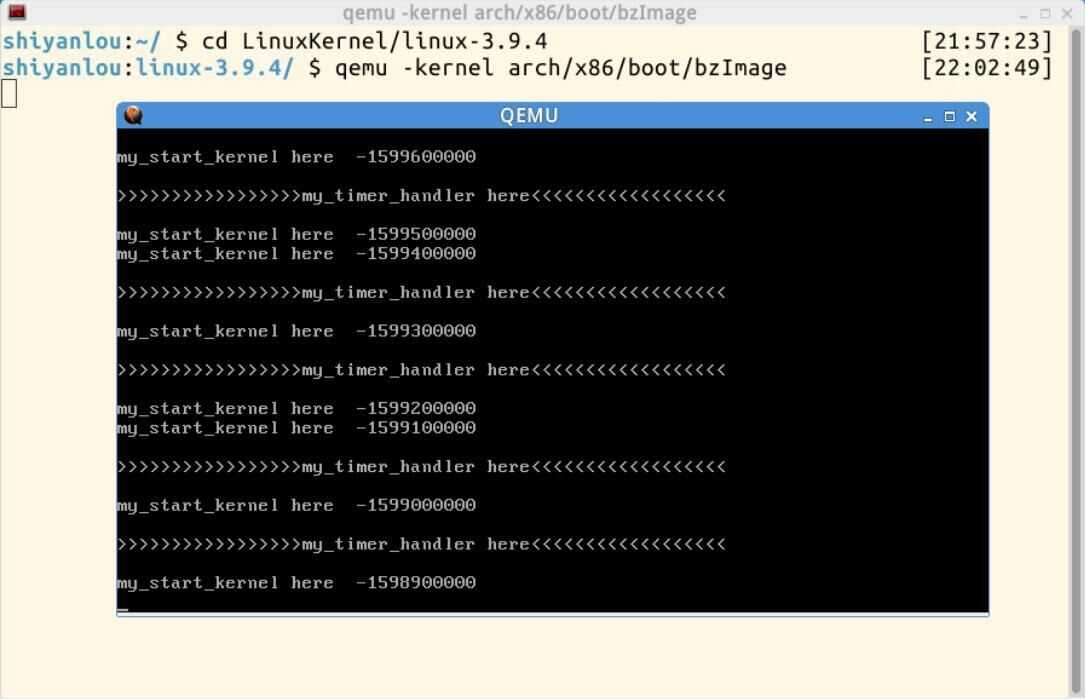标签:
范闻泽 原创作品转载请注明出处 《Linux内核分析》MOOC课程http://mooc.study.163.com/course/USTC-1000029000

根据实验要求,在实验楼中的运行。

时间片轮转法

(输入vi main.c查看mykernel的源代码)

mymain.c中最核心的代码

(myinterrupt.c的代码,每次时钟中断调用一次printk)
1.mypcb.h//头文件,在其他的.c文件中引用;主要是数据结构的定义
1 /*
2 * linux/mykernel/mypcb.h
3 *
4 * Kernel internal PCB types
5 *
6 * Copyright (C) 2013 Mengning
7 *
8 */
9
10 #define MAX_TASK_NUM 4
11 #define KERNEL_STACK_SIZE 1024*8
12
13 /* CPU-specific state of this task */
14 struct Thread {
15 unsigned long ip; //
16 unsigned long sp;
17 };
18
19 typedef struct PCB{ //定义进程相关的数据结构
20 int pid; //定义进程id
21 volatile long state; /* -1 unrunnable, 0 runnable, >0 stopped */
22 char stack[KERNEL_STACK_SIZE]; //内核堆栈
23 /* CPU-specific state of this task */
24 struct Thread thread;
25 unsigned long task_entry; //进程入口
26 struct PCB *next; //进程链表
27 }tPCB;
28
29 void my_schedule(void); //调度器
2.mymain.c 内核初始化和0号进程启动
1 /*
2 * linux/mykernel/mymain.c
3 *
4 * Kernel internal my_start_kernel
5 *
6 * Copyright (C) 2013 Mengning
7 *
8 */
9 #include <linux/types.h>
10 #include <linux/string.h>
11 #include <linux/ctype.h>
12 #include <linux/tty.h>
13 #include <linux/vmalloc.h>
14
15
16 #include "mypcb.h"
17
18 tPCB task[MAX_TASK_NUM]; //声明一个pcb数组
19 tPCB * my_current_task = NULL;
20 volatile int my_need_sched = 0;
21
22 void my_process(void);
23
24
25 void __init my_start_kernel(void)
26 {
27 int pid = 0;
28 int i;
29 /* Initialize process 0*/ //初始化0号进程数据结构
30 task[pid].pid = pid;
31 task[pid].state = 0;/* -1 不可运行, 0 可运行, >0 停止*/
32 task[pid].task_entry = task[pid].thread.ip = (unsigned long)my_process; //入口
33 task[pid].thread.sp = (unsigned long)&task[pid].stack[KERNEL_STACK_SIZE-1]; //堆栈的栈顶位置,在mypcb.h中也有定义
34 task[pid].next = &task[pid]; //next指向自己
35 /*fork more process */
36 for(i=1;i<MAX_TASK_NUM;i++)
37 {
38 memcpy(&task[i],&task[0],sizeof(tPCB)); //复制0号进程的状态
39 task[i].pid = i;
40 task[i].state = -1; //
41 task[i].thread.sp = (unsigned long)&task[i].stack[KERNEL_STACK_SIZE-1];
42 task[i].next = task[i-1].next; //
43 task[i-1].next = &task[i];
44 }
45 /* start process 0 by task[0] */ //0号进程启动
46 pid = 0; //
47 my_current_task = &task[pid];
48 asm volatile(
49 "movl %1,%%esp\n\t" /* set task[pid].thread.sp to esp */ //确定esp的位置
50 "pushl %1\n\t" /* push ebp */ //ebp等于esp
51 "pushl %0\n\t" /* push task[pid].thread.ip */ //IP压栈
52 "ret\n\t" /* pop task[pid].thread.ip to eip */
53 "popl %%ebp\n\t" //ebp出栈,内核初始化工作完成
54 :
55 : "c" (task[pid].thread.ip),"d" (task[pid].thread.sp) /* input c or d mean %ecx/%edx*/
56 );
57 }
58 void my_process(void)
59 {
60 int i = 0;
61 while(1)
62 {
63 i++;
64 if(i%10000000 == 0)
65 {
66 printk(KERN_NOTICE "this is process %d -\n",my_current_task->pid);
67 if(my_need_sched == 1)
68 {
69 my_need_sched = 0;
70 my_schedule();
71 }
72 printk(KERN_NOTICE "this is process %d +\n",my_current_task->pid);
73 }
74 }
75 }
3myinterrupt.c 调度机制
1 /*
2 * linux/mykernel/myinterrupt.c
3 *
4 * Kernel internal my_timer_handler
5 *
6 * Copyright (C) 2013 Mengning
7 *
8 */
9 #include <linux/types.h>
10 #include <linux/string.h>
11 #include <linux/ctype.h>
12 #include <linux/tty.h>
13 #include <linux/vmalloc.h>
14
15 #include "mypcb.h"
16
17 extern tPCB task[MAX_TASK_NUM];
18 extern tPCB * my_current_task;
19 extern volatile int my_need_sched;
20 volatile int time_count = 0;
21
22 /*
23 * Called by timer interrupt.
24 * it runs in the name of current running process,
25 * so it use kernel stack of current running process
26 */
27 void my_timer_handler(void)
28 {
29 #if 1
30 if(time_count%1000 == 0 && my_need_sched != 1) //设置时间片的大小,时间片用完时设置一下调度标志
31 {
32 printk(KERN_NOTICE ">>>my_timer_handler here<<<\n");
33 my_need_sched = 1;
34 }
35 time_count ++ ;
36 #endif
37 return;
38 }
39
40 void my_schedule(void)
41 {
42 tPCB * next;
43 tPCB * prev;
44
45 if(my_current_task == NULL
46 || my_current_task->next == NULL)
47 {
48 return;
49 }
50 printk(KERN_NOTICE ">>>my_schedule<<<\n");
51 /* schedule */
52 next = my_current_task->next;
53 prev = my_current_task;
54 if(next->state == 0)/* -1 unrunnable, 0 runnable, >0 stopped */
55 {
56 /* switch to next process */
57 asm volatile(
58 "pushl %%ebp\n\t" /* save ebp */
59 "movl %%esp,%0\n\t" /* save esp */
60 "movl %2,%%esp\n\t" /* restore esp */
61 "movl $1f,%1\n\t" /* save eip */
62 "pushl %3\n\t"
63 "ret\n\t" /* restore eip */
64 "1:\t" /* next process start here */
65 "popl %%ebp\n\t"
66 : "=m" (prev->thread.sp),"=m" (prev->thread.ip)
67 : "m" (next->thread.sp),"m" (next->thread.ip)
68 );
69 my_current_task = next;
70 printk(KERN_NOTICE ">>>switch %d to %d<<<\n",prev->pid,next->pid
71 }
72 else
73 {
74 next->state = 0;
75 my_current_task = next;
76 printk(KERN_NOTICE ">>>switch %d to %d<<<\n",prev->pid,next->pid);
77 /* switch to new process */
78 asm volatile(
79 "pushl %%ebp\n\t" /* save ebp */
80 "movl %%esp,%0\n\t" /* save esp */
81 "movl %2,%%esp\n\t" /* restore esp */
82 "movl %2,%%ebp\n\t" /* restore ebp */
83 "movl $1f,%1\n\t" /* save eip */
84 "pushl %3\n\t" //保存当前进程的入口
85 "ret\n\t" /* restore eip */
86 : "=m" (prev->thread.sp),"=m" (prev->thread.ip)
87 : "m" (next->thread.sp),"m" (next->thread.ip)
88 );
89 }
90 return;
91 }
1.存储程序计算机,中断机制和堆栈使计算机变得更加简单方便。
2.中断和上下文进程切换是操作系统的必备操作。
标签:
原文地址:http://www.cnblogs.com/fwzfwz/p/5248895.html